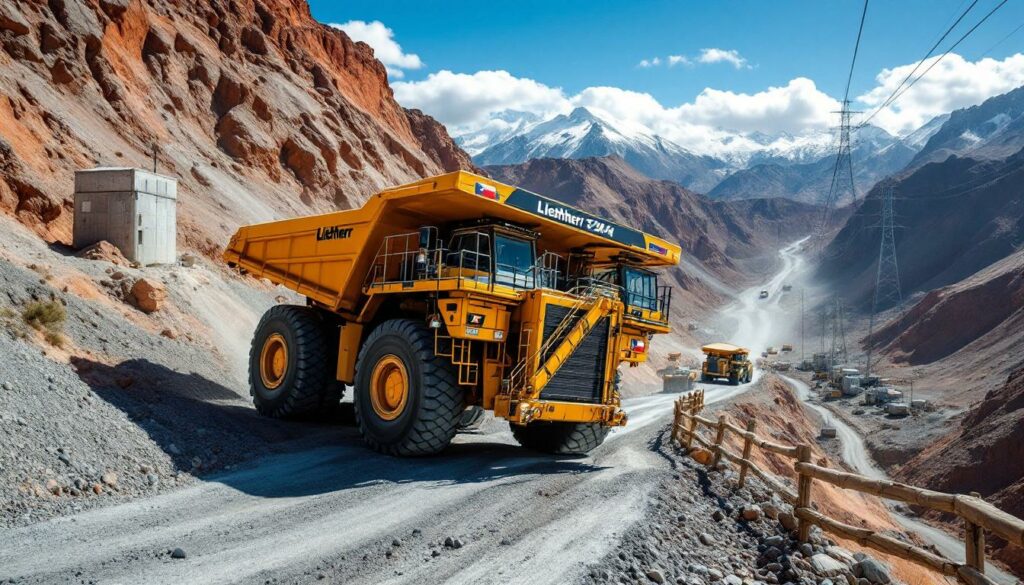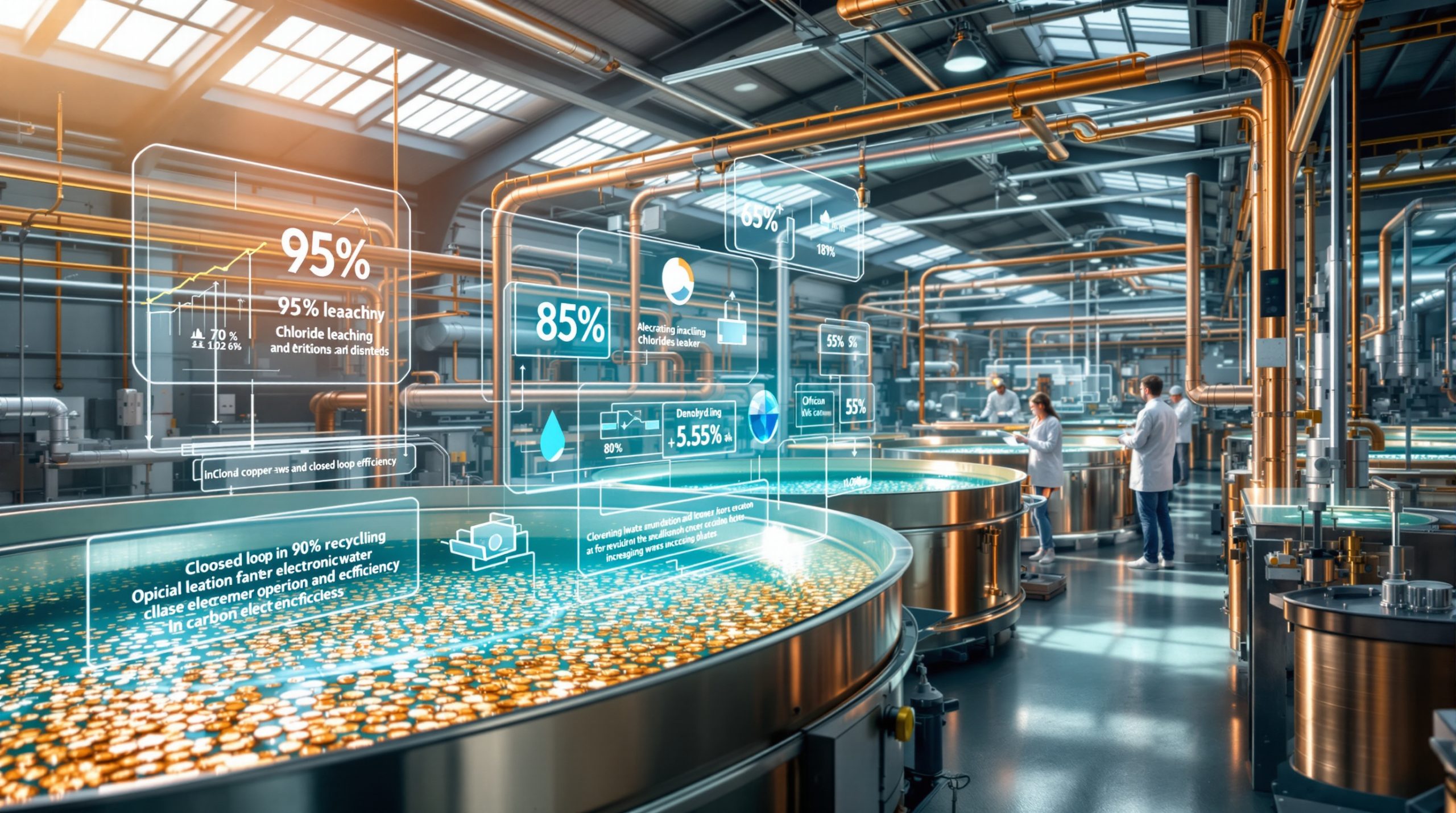How Does Liebherr's Trolley Mining Solution Work at Collahuasi Copper Mine?
High in the Andes Mountains of northern Chile, at an altitude of 4,500 meters above sea level, a groundbreaking mining innovation is transforming operations at one of the world's largest copper mines. Liebherr's trolley mining solution at Collahuasi copper mine represents Chile's first fully operational trolley system for mining operations, marking a significant advancement in sustainable mining electrification practices in South America.
The implementation combines cutting-edge electrical engineering with robust mining equipment, designed specifically to withstand the extreme conditions of high-altitude mining while delivering substantial operational and environmental benefits.
What Is Liebherr's Trolley Mining Solution?
The Technology Behind Trolley-Assisted Mining
Liebherr's trolley mining solution represents a hybrid approach to powering ultra-class haul trucks, combining traditional diesel engines with electric power infrastructure. At its core, the system features overhead catenary lines—similar to those seen in electric tram systems—supported by specially engineered masts. These overhead lines supply electricity directly to haul trucks equipped with pantograph systems (extendable power collectors mounted on the trucks).
The genius of the system lies in its targeted approach: when trucks travel uphill on designated trolley routes—the most energy-intensive part of mining operations—they connect to the overhead power lines, automatically switching from diesel to electric power. This strategic electrification of the most demanding segments delivers maximum efficiency benefits while minimizing infrastructure requirements.
As Oliver Weiss, Executive Vice President of Liebherr-Mining SAS Equipment R&D, Engineering and Production explains: "The trolley system targets the most energy-intensive aspect of the haul cycle, generating significant operational and environmental improvements with relatively modest infrastructure investments compared to full fleet electrification."
Key Components of the Collahuasi Installation
The Collahuasi implementation features several critical components engineered specifically for the extreme mining environment:
- 1-kilometer trolley line strategically positioned on uphill haul routes
- Two powerful 5.5-megawatt transformers providing reliable power supply
- Specialized e-house systems for power management and protection
- Custom-designed masts and catenary lines engineered for high-altitude, high-wind, and seismic conditions
- Four retrofitted Liebherr T 284 ultra-class trucks with sophisticated pantograph technology
The pantograph system itself represents a marvel of engineering, featuring automatic height adjustment, pressure control for optimal contact, and safety systems that instantly disengage if alignment issues occur—all designed to operate flawlessly in challenging high-altitude conditions.
Why Is the Collahuasi Implementation Significant?
First Full Trolley System in South America
The Collahuasi project represents Liebherr's first complete trolley system installation in South America, establishing a precedent for similar implementations across the resource-rich region. While trolley-assisted mining has been successfully implemented in other parts of the world, particularly in Africa, the Collahuasi system demonstrates the technology's viability in the unique operating conditions of South American mining operations.
"This installation serves as a living laboratory for mining operations throughout the Andes region," notes Gonzalo Garcia, Managing Director of Liebherr Chile. "The successful deployment here opens doors for mining companies across Peru, Chile, and Argentina to adopt similar technology, adapted to their specific operational requirements."
Extreme Environmental Challenges Overcome
What truly sets the Collahuasi implementation apart is the extraordinary environmental challenges that had to be overcome:
- Extreme altitude: At 4,500 meters above sea level, the thin atmosphere affects equipment performance, electrical systems, and human workers
- High wind exposure: Regular wind speeds exceeding 60 km/h required specialized structural engineering for the overhead line system
- Seismic activity: Located in one of the world's most seismically active regions, all infrastructure required earthquake-resistant design
- Temperature fluctuations: Daily temperature variations of up to 30°C (86°F) demanded materials and components capable of withstanding thermal expansion and contraction
- Electrical challenges: High-altitude affects electrical insulation requirements and arcing risks, necessitating specialized electrical engineering
The successful implementation under these extreme conditions demonstrates the adaptability of trolley mining technology and Liebherr's engineering capabilities.
How Was the Trolley System Implemented?
Global Collaboration and Sourcing Strategy
The implementation leveraged Liebherr's international expertise and supply chain, showcasing the truly global nature of modern mining innovation trends:
- Trolley system masts and catenary lines: Engineered in Chile to meet local seismic and wind requirements
- Transformers and e-house systems: Sourced from South Africa, drawing on expertise from mining operations in that region
- Truck retrofitting support: Provided by Liebherr's facility in Newport News, Virginia, with specialized knowledge in ultra-class truck systems
- Control systems: Developed by Liebherr's electrical engineering team in Germany
- Installation expertise: Drawn from previous implementations in African mining operations
This international collaboration ensured that best practices and specialized knowledge from different mining regions could be adapted and applied to the unique challenges at Collahuasi.
Comprehensive Project Scope
Liebherr provided end-to-end implementation services, encompassing:
- Initial feasibility studies and route optimization analysis
- Detailed design and engineering of the infrastructure
- Truck modification specifications and retrofitting supervision
- Construction oversight and quality control throughout installation
- System commissioning and performance verification
- Comprehensive operator and maintenance training programs
- Ongoing technical support during operational ramp-up
The implementation timeline spanned approximately 18 months from initial planning to full operational status, with careful phasing to minimize disruption to ongoing mining operations.
What Are the Technical Specifications of the System?
Power Infrastructure Details
The power system for the Collahuasi trolley implementation features robust components designed for reliability in extreme conditions:
- Two 5.5-megawatt transformers enabling simultaneous operation of multiple trucks
- Primary voltage: 23kV, secondary voltage: 1600V DC for trolley line operation
- Specialized high-altitude electrical insulation and protection systems
- Redundant power management systems to ensure operational continuity
- Advanced monitoring systems tracking power consumption and system health
- Seismic-resistant mounting systems for all electrical components
- Lightning protection designed for high-altitude atmospheric conditions
The power infrastructure is designed with 30% excess capacity to accommodate future expansion and additional trucks as the system proves its value.
Truck Modifications
Four Liebherr T 284 ultra-class trucks were retrofitted with sophisticated trolley capability:
- Advanced pantograph systems with automatic height adjustment and pressure control
- Dual-mode propulsion systems enabling seamless transition between diesel and electric power
- Modified control systems integrating trolley operation into standard truck functions
- Enhanced cooling systems for electric components
- Reinforced electrical systems designed for high-altitude operation
- Driver interface systems providing real-time feedback on trolley connection status
- Data logging systems tracking performance metrics and energy consumption
The truck modifications were designed to maintain full operational capability even when trolley lines are unavailable, ensuring operational flexibility.
What Benefits Does the Trolley System Provide?
Operational Advantages
The trolley system delivers multiple operational benefits that directly impact the mine's productivity and operating costs:
- Reduced diesel consumption: Up to 85% less diesel used during uphill hauling segments
- Increased truck speed: Approximately 40% higher uphill speed when operating in trolley mode
- Enhanced productivity: 20-25% improvement in cycle times, resulting in higher material movement
- Extended engine life: Significantly reduced load on diesel engines during the most demanding operational phase
- Lower maintenance requirements: Reduced wear on engine components and drive systems
- Improved reliability: Electric systems generally offer higher reliability than pure mechanical systems
- Enhanced operator experience: Reduced noise and vibration in trolley mode improves driver comfort
These operational benefits translate directly to improved cost-effectiveness and production capacity at the mine.
Environmental and Sustainability Benefits
Beyond operational improvements, the trolley system delivers substantial mining decarbonisation benefits:
- Reduced emissions: Approximately 85% reduction in CO₂ emissions during trolley-assisted segments
- Lower particulate emissions: Significant reduction in diesel particulates, improving air quality at the mine site
- Noise reduction: Electric operation is substantially quieter than diesel engines at full power
- Alignment with ESG goals: Supports corporate environmental commitments and reporting requirements
- Energy efficiency: Electric motors are inherently more efficient than diesel engines for high-load applications
- Path to further electrification: Creates infrastructure foundation for additional electrification initiatives
In an era of increasing focus on mining's environmental impact, these sustainability benefits represent a significant advantage for Collahuasi's operators and stakeholders.
Who Are the Key Stakeholders in the Project?
Mine Ownership and Management
The Collahuasi copper mine operates under a joint ownership structure:
- Anglo American: 44% ownership stake
- Glencore: 44% ownership stake
- Japan Collahuasi Resources B.V.: 12% ownership stake (consortium of Japanese companies)
The trolley implementation represents a collaborative investment by these stakeholders, aligned with their shared commitment to operational excellence and environmental responsibility.
Liebherr Project Leadership
Key Liebherr executives involved in the project include:
- Oliver Weiss: Executive Vice President of Liebherr-Mining SAS Equipment R&D, Engineering and Production
- Gonzalo Garcia: Managing Director of Liebherr Chile
- Technical leadership team: Drawing expertise from Liebherr's global mining operations and previous trolley implementations
The project also involved close collaboration with Collahuasi's operational and engineering teams to ensure seamless integration with existing mining processes.
What Is the Future Outlook for Trolley Mining?
Expansion Potential at Collahuasi
The current implementation at Collahuasi represents just the first phase of potential trolley expansion:
- Extended trolley coverage: Plans to extend the trolley line to cover additional haul routes are under consideration
- Additional truck retrofits: Success with the initial four trucks could lead to retrofitting more of the fleet
- Increased power capacity: Infrastructure could be expanded to allow more simultaneous truck operation
- Integration with renewable energy: Potential to connect the trolley system to renewable energy integration
- Automation integration: Future possibilities to combine trolley operation with autonomous truck technologies
The modular nature of the trolley system allows for phased expansion as operational benefits are validated.
Industry-Wide Implications
The successful implementation at Collahuasi has significant implications for the broader mining industry:
- Validation in extreme conditions: Demonstrates viability in challenging high-altitude environments
- South American adoption catalyst: Creates a regional reference point for other mining operations
- Technology refinement: Lessons learned will inform future implementations worldwide
- Standards development: Contributes to emerging standards for mining electrification
- Supplier ecosystem development: Encourages development of specialized components and services
- Mining decarbonization pathway: Provides a practical step toward reduced carbon footprints
As mining companies worldwide face increasing pressure to reduce emissions while maintaining productivity, the Collahuasi implementation offers a proven model for consideration.
How Was Training and Knowledge Transfer Handled?
Comprehensive Training Program
Liebherr implemented a thorough training regimen for mine personnel to ensure successful adoption of the new technology:
- Operator training: Specialized instruction for drivers operating trolley-equipped trucks
- Maintenance procedures: Detailed training on pantograph systems and electrical components
- Infrastructure maintenance: Protocols for catenary line inspection and maintenance
- Troubleshooting: Systematic approaches to diagnosing and resolving system issues
- Safety protocols: Comprehensive safety procedures for working with high-voltage systems
- Performance optimization: Techniques for maximizing operational benefits of the system
The training program utilized a combination of classroom instruction, simulator-based practice, and supervised operational experience to ensure comprehensive knowledge transfer.
"The success of any new mining technology depends as much on effective knowledge transfer as on the technology itself. Our comprehensive training approach ensures that Collahuasi's team can fully own and optimize the system for their specific operational requirements." — Oliver Weiss, Liebherr-Mining SAS
FAQ: Liebherr Trolley Mining at Collahuasi
What makes the Collahuasi implementation unique?
The Collahuasi trolley system operates at an extreme altitude of 4,500 meters above sea level in challenging conditions including high winds and seismic activity, making it a pioneering example of electric mining technology in demanding environments. The site's combination of altitude, temperature variations, and wind conditions required specialized engineering solutions not needed in other trolley implementations worldwide.
How many trucks can operate on the trolley line simultaneously?
The current power infrastructure, featuring two 5.5-megawatt transformers, enables two Liebherr T 284 ultra-class trucks to operate on the line simultaneously. The system includes power management capabilities that automatically balance available power between connected trucks to ensure optimal performance.
What is the length of the trolley line at Collahuasi?
The trolley line spans approximately 1 kilometer along an uphill haul route at the mine. This strategic placement targets the most energy-intensive segment of the haul cycle, maximizing return on infrastructure investment while minimizing required construction.
Who manufactured the components for the trolley system?
The system utilizes globally sourced components: trolley masts and catenary lines engineered in Chile, transformers and e-house systems from South Africa, and truck retrofitting supported by Liebherr's Virginia facility. This international sourcing strategy leveraged specialized expertise from different regions while ensuring components were appropriate for the unique conditions at Collahuasi.
What ongoing support does Liebherr provide after implementation?
Liebherr continues to offer technical support as the mine takes full operational control of the system, including:
- Remote monitoring and diagnostics
- Performance optimization consultation
- Periodic system audits and health checks
- Advanced training for new personnel
- Technical support for expansion planning
- Software updates and system improvements
This ongoing partnership ensures that the system continues to deliver optimal performance throughout its operational life.
Conclusion: Setting New Standards for Mining Sustainability
The successful implementation of Liebherr's trolley mining solution at the Collahuasi copper mine represents more than just a technological achievement—it demonstrates a practical path forward for copper mining insights seeking to balance productivity, cost control, and environmental responsibility.
By strategically electrifying the most energy-intensive segments of the mining cycle, the trolley system delivers substantial benefits with relatively modest infrastructure investments. The proven success in Collahuasi's extreme conditions establishes a compelling case study for mining operations worldwide, particularly in South America's resource-rich Andean region.
As the mining industry continues its journey toward greater sustainability, innovative approaches like Liebherr's complete trolley solution will play an increasingly important role in reducing environmental impact while maintaining the productivity needed to meet global demand for essential minerals and metals.
The Collahuasi implementation is already being studied by other mining operators, with industry experts highlighting the potential for widespread adoption of similar systems throughout the region.
Disclaimer: This article contains information about mining technologies and potential future developments. All performance figures and projections are based on reported data and industry analysis. Actual results may vary based on specific operational conditions, commodity prices, and other factors beyond the control of equipment manufacturers or mine operators.
Are You Tracking the Latest Mining Innovations?
Stay ahead of transformative technologies shaping the mining industry's future by subscribing to Discovery Alert's proprietary Discovery IQ model, delivering real-time insights on significant developments across the ASX. Explore how these innovations translate into investment opportunities by visiting our discoveries page today.




